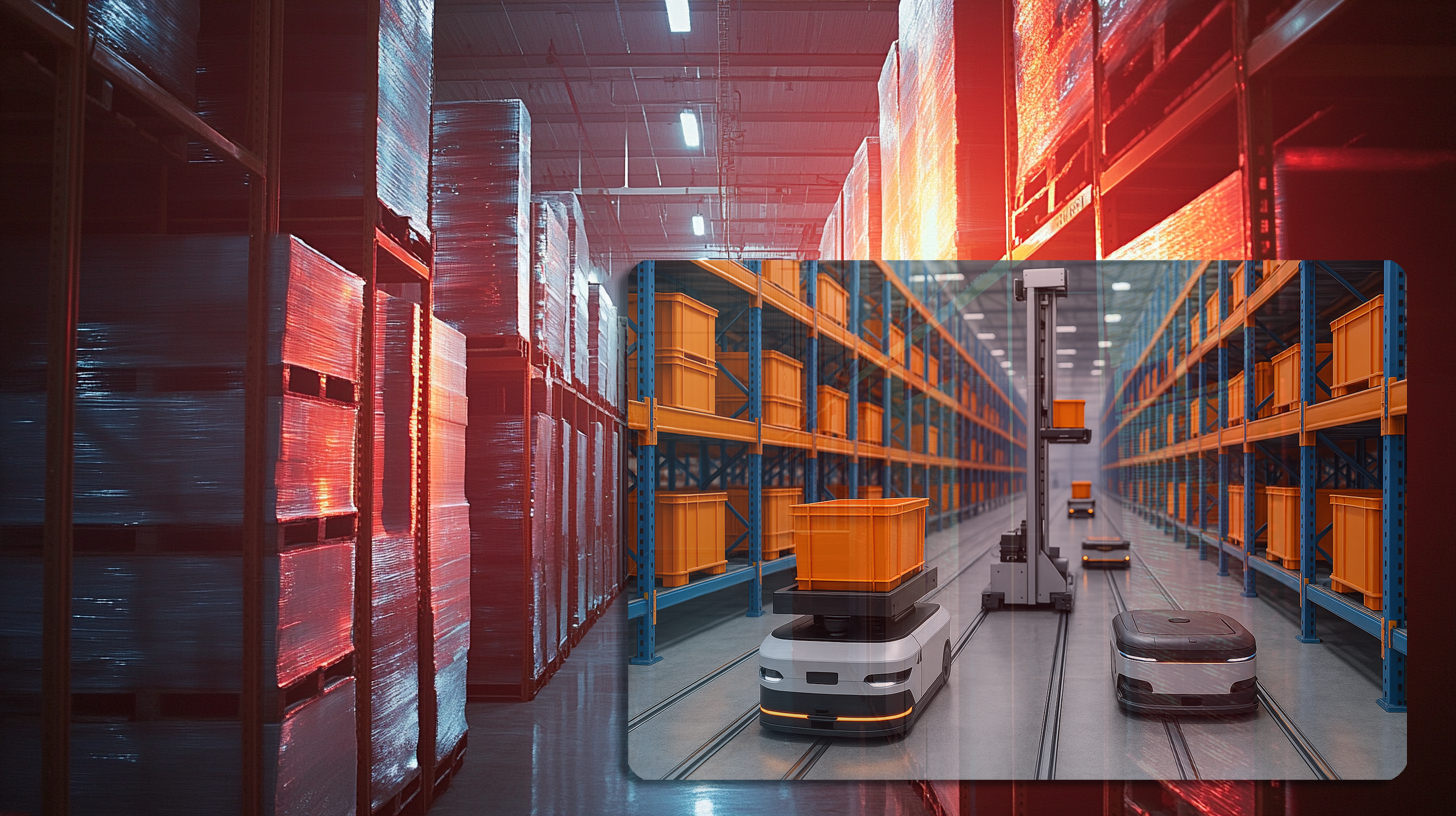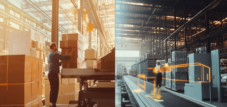From the trend towards the need: why robotics redefined intralogistics
Automation in intralogistics: opportunities for SMEs in technology change
The intralogistics sector is at the turning point of a significant transformation, whereby automation technologies grow significantly faster than the overall market. While the European intralogistics automation market progresses with a considerable annual growth rate of 11.6%, sub-areas such as robotics develop even more dynamic annually with astonishing 21.9%. This discrepancy illustrates a fundamental change in the industry: despite the initial reluctance of many companies, fully automated solutions are becoming increasingly important. In the meantime, pioneers in technology development rely on holistic concepts ranging from autonomous mobile robots (AMRS) to artificial intelligence to virtual reality applications in system planning. It is particularly noteworthy that these technologies are now also accessible to small and medium -sized companies, which marks the turning point into an exponential market growth.
Suitable for:
- Daifuku Europe: Automation of intralogistics through autonomous mobile robots (AMR) and automated guided vehicle (AGV)
Market growth and dynamics of the automation landscape
The European market for intralogistics automation is in a crucial growth phase. With a predicted CAGR of 11.6% by 2029, it is one of the most dynamic sectors of industrial automation. However, it is noteworthy that different areas of automation technology exceed this already high growth.
Above average growth in the robotic sector
The development in the robotic sector is particularly striking. While the overall market for intralogistic automation in Europe is around 9.88 billion euros (as of 2021) with an annual growth of 5.7%, the robotic share grows with impressive 21.9% per year. This discrepancy between general market growth and the rapid development of specific technologies illustrates an important trend: highly specialized automation solutions develop much faster than the overall market.
The upcoming turning point
Experts agree that the market for the automation of intralogistics is about to be a decisive turning point. After a phase of slow growth with numerous pilot projects and test installations, analysts now expect a transition to exponential growth. This assessment is supported by several factors, including the increasing market maturity of the technologies, falling implementation costs and increasing acceptance in users of different sizes.
Driving factors for accelerated technology growth
Several key factors drive the above -average development of automation technologies in intralogistics, which goes far beyond general market growth.
Demographic change and labor shortage
An essential driver is the increasing lack of workers in the logistics industry. According to forecasts, over 400,000 workers could be missing from the European logistics sector by 2025. This demographic challenge forces companies to automate processes in order to maintain their competitiveness. Purely manually operated material flow solutions become increasingly inefficient and expensive under these conditions.
Suitable for:
- SME Robotics (Cobotics) with Coboworx: Innovative rental robots as a solution against a shortage of skilled workers and high personnel costs
Technological progress and cost reductions
Technological development and the associated cost reductions significantly accelerate market penetration. The prices for essential components such as semiconductors, IoT devices and control systems decrease rapidly. A clear example is the drop in prices for lithium-ion batteries that are indispensable for mobile robot systems: from around $ 1,200 per kWh in 2010 to less than $ 150 per kWh in 2020. This cost reduction makes automation solutions accessible for a broader mass to companies.
Rising market requirements and competitive pressure
Despite economic uncertainties, automation remains a central driver in intralogistics. The use of robots and intelligent systems continues to increase because they can increase efficiency, reduce error rates and compensate for the shortage of labor. New standards are constantly being set in e-commerce: Fast and precise fulfillment processes have become indispensable, which increases the pressure to implement the latest technologies.
Innovative technologies and solutions
The above-average development of specific sub-areas of intralogistics automation is based on a variety of innovative technologies that are used in different combinations.
Autonomous robotics and mobile systems
Autonomous mobile robots (AMRS) and driverless transport systems (FTS) revolutionize the material flows in camps and distribution centers. In contrast to conventional driverless transport vehicles (AGVS), modern AMRs have more sophisticated on-board computers with laser scanning, 3D cameras and intelligent engine controls. These advanced systems enable a completely new form of inventory management, for example through independent inventory-wets according to predefined schedules.
Artificial intelligence and machine learning
AI and machine learning significantly contributes to the increase in efficiency in intralogistics. By analyzing large amounts of data, algorithms can be used to optimize inventory, supply chains and demand forecasts. An example is algorithms for warehouse occupancy control, which significantly improve the efficiency of warehousing, or machine learning-based recognition systems for the automated recording of truck tarpaulin prints and license plates when receipt of goods.
Immersive technologies for planning and control
In addition to concrete automation solutions, technologies such as Virtual Reality (VR) and Augmented Reality (AR) are becoming increasingly important. You have the potential to fundamentally change the planning and presentation of logistics systems. The first companies are already using VR to keep in storage layouts and automation systems so that customers can simulate warehouse structures and carry out ergonomic tests before systems are physically installed.
Challenges and overcoming implementation hurdles
Despite the above -average growth of certain technology segments, there are still significant obstacles to a nationwide implementation.
Overcoming fear of contact and misconception
A majority of potential users are still afraid of contact with the relatively young automation technologies. Supposedly high costs, the assumption that automation is only possible in specially designed warehouse -layouts or new buildings, as well as a market perceived as a confusing market are common reasons for restraint. However, these concerns often no longer meet the real conditions of today's automation solutions.
Scalable solutions for different company sizes
A decisive factor for the increasing market penetration is the development of scalable solutions that are not only accessible to large companies, but also for small and medium -sized companies. Leading providers are increasingly relying on standardized products, combined with personal advice and tailored service packages. This strategy also enables smaller companies to start with a basic solution and to expand them modularly as required.
Suitable for:
- Why do we need artificial intelligence? – What does this have to do with speed, flexibility, automation and scalability of the market?
Integration into existing infrastructures
The seamless integration of automation solutions into existing infrastructures is another challenge. Modern solutions therefore focus on flexibility and adaptability. The creation of a central data point (Single Point of Truth) ensures stable, transparent and reliable communication between all systems involved, which makes planning, implementation and monitoring significantly easier.
Figure prospects: the way to exponential growth
The current developments and trends clearly indicate an acceleration of growth in the area of intralogistics automation, whereby certain technology segments will significantly overtake the overall market.
Market forecasts and expected developments for 2025
For 2025, experts predict the dominance of the following trends: increasing automation, increased focus on investment security and flexibility as well as more intensive use of virtual and augmented reality in system planning and presentation. The market for mobile robots is expected to achieve a volume of $ 29.86 billion in 2025, which underlines the growing importance of this technology.
Convergence of different technologies
A crucial factor for the above -average growth of certain technology segments is the increasing convergence of various innovation fields. The combination of robotics, artificial intelligence, IoT and cloud computing creates synergies that go far beyond the possibilities of individual technologies. These integrated solutions enable companies to optimize their intralogistics, reduce costs and achieve significantly higher efficiency.
New fields of application and business models
With the technological development, new fields of application and business models are continuously created. Future-oriented approaches such as the use of last-mile technologies-including drones, micro-ferrot centers and intelligent delivery networks-address the increasing demands on delivery speeds and sustainability. Specialized systems such as cleaning robots and drones for inventory monitoring are also becoming increasingly important.
The technology acceleration as a growth engine
The analysis of market developments clearly shows that certain technology segments within intralogistics automation actually grow significantly faster than the overall market. While the European automation market is growing with a remarkable 11.6% annually, sub-areas such as robotics with 21.9% develop more than three times as quickly as the general intralogistics automation market (5.7%).
This discrepancy illustrates that we are at a critical turning point. After a phase of testing and gradual implementation, we are now at the beginning of an exponential growth that is driven by technological innovations, falling costs and increasing market acceptance. The future of intralogistics belongs to flexible, scalable and intelligent automation solutions that are not only accessible to large companies, but also for small and medium -sized businesses.
Companies that recognize this development at an early stage and implement appropriate technologies will benefit from faster material movements, higher storage density, better order processing rates and lower operating costs - and thus gain a decisive competitive advantage. Automation technology not only grows faster than the market - it fundamentally transforms it.
Suitable for:
We are there for you - advice - planning - implementation - project management
☑️ Our business language is English or German
☑️ NEW: Correspondence in your national language!
I would be happy to serve you and my team as a personal advisor.
You can contact me by filling out the contact form or simply call me on +49 89 89 674 804 (Munich) . My email address is: wolfenstein ∂ xpert.digital
I'm looking forward to our joint project.


